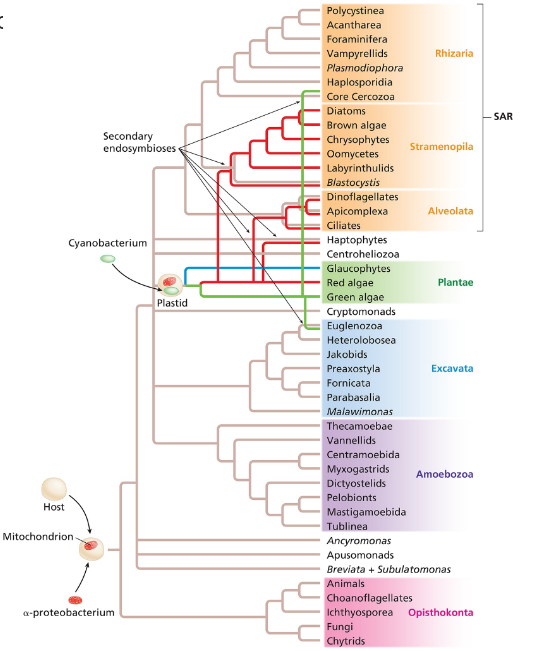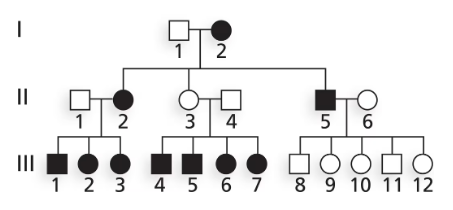 Back
Back Sanders 3rd Edition
Sanders 3rd Edition Ch. 17 - Organelle Inheritance and the Evolution of Organelle Genomes
Ch. 17 - Organelle Inheritance and the Evolution of Organelle GenomesProblem 1
Reciprocal crosses of experimental animals or plants sometimes give different results in the F1. What are two possible genetic explanations? How would you distinguish between these two possibilities (i.e., what crosses would you perform, and what would the results tell you)?
Problem 2
How are some of the characteristics of the organelles (the mitochondria and chloroplasts) explained by their origin as ancient bacterial endosymbionts?
Problem 3
The human mitochondrial genome encodes only 22 tRNAs, but at least 32 tRNAs are needed for cytoplasmic translation. How are all codons in mitochondrial transcripts accommodated by only 22 tRNAs? The Plasmodium mitochondrial genome does not encode any tRNAs; how are genes of the Plasmodium mitochondrial genome translated?
Problem 4
What is the evidence that transfer of DNA from the organelles to the nucleus continues to occur?
Problem 5
Draw a graph depicting the relative amounts of nuclear DNA present in the different stages of the cell cycle (G₁,S,G₂,M). On the same graph, plot the amount of mitochondrial DNA present at each stage of the cell cycle.
Problem 6
What are the differences between the universal code and that found in the mitochondria of some species? Given that some changes (UGA =stop→Trp) have occurred multiple independent times in evolution, can you think of any selective advantage to the mitochondrial code?
Problem 7
What is the evidence that the ancient mitochondrial and chloroplast endosymbionts are related to the alphaproteobacteria and cyanobacteria, respectively?
Problem 8
Outline the steps required for a gene originally present in the endosymbiont genome to be transferred to the nuclear genome and be expressed, and for its product to be targeted back to the organelle of origin.
Problem 9
Consider the phylogenetic tree presented in the following figure (Figure 17.17). How were the origins of secondary endosymbiosis in the brown algae determined?
Problem 10
You are a genetic counselor, and several members of the family whose pedigree for an inherited disorder is depicted in Genetic Analysis 17.2 consult with you about the probability that their progeny may be afflicted. What advice would you give individuals III-1, III-2, III-4, III-6, III-8, and III-9?
Problem 11
A mutation in Arabidopsis immutans results in the necrosis (death) of tissues in a mosaic configuration. Examination of the mitochondrial DNA detects deletions of various regions of the mitochondrial genome in the tissues that are necrotic. When immutans plants are crossed with wild-type plants, the are wild type, and the are wild type and immutans in a 3:1 ratio. Explain the inheritance of the immutans mutation and a possible origin of the mitochondrial DNA deletions.
Problem 12
What type or types of inheritance are consistent with the following pedigree?

Problem 13
You have isolated (1) a streptomycin-resistant mutant (strᴿ) of Chlamydomonas that maps to the chloroplast genome and (2) a hygromycin-resistant mutant (hygᴿ) of Chlamydomonas that maps to the mitochondrial genome. What types of progeny do you expect from the following reciprocal crosses?
mt⁺ strᴿ hygˢ× mt⁻ strˢ hygᴿ
mt⁺ strˢ hygᴿ× mt⁻ strᴿ hygSˢ
Problem 14
You have isolated two petite mutants, pet1 and pet2, in Saccharomyces cerevisiae. When pet1 is mated with wild-type yeast, the haploid products following meiosis segregate 2:2 (wild type : petite). In contrast, when pet2 is mated with wild type, all haploid products following meiosis are wild type. To what class of petite mutations does each of these petite mutants belong? What types of progeny do you expect from a pet1 × pet2 mating?
Problem 15
Consider this human pedigree for a vision defect.

What is the most probable mode of inheritance of the disease? Identify any discrepancies between the pedigree and your proposed mode of transmission, and provide possible explanations for these exceptions.
Problem 16
A 50-year-old man has been diagnosed with MELAS syndrome. His wife is phenotypically normal, and there is no history of MELAS syndrome in either of their families. The couple is concerned about whether their children will develop the disease. As a genetic counselor, what will you tell them? Would your answer change if it were the mother who exhibited disease symptoms rather than the father?
Problem 17
The first person in a family to exhibit Leber hereditary optic neuropathy (LHON) was II-3 in the pedigree shown below, and all of her children also exhibited the disease. Provide two possible explanations as to why II-3's mother (I-1) did not exhibit symptoms of LHON.

Problem 18
The following pedigree shows a family in which several individuals exhibit symptoms of the mitochondrial disease MERRF. Two siblings (II-2 and II-5) approach you to inquire about whether their children will also be afflicted with MERRF. What do you tell them?

Problem 19
What is the most likely mode of inheritance for the trait depicted in the following human pedigree?

Problem 20
In 1918, the Russian tsar Nicholas II was deposed, and he and his family were reportedly executed and buried in a shallow grave. During this chaotic time, rumors abounded that the youngest daughter, Anastasia, had escaped. In 1920, a woman in Germany claimed to be Anastasia. In 1979, remains were recovered for the tsar, his wife (the Tsarina Alexandra), and three of their children, but not Anastasia. How would you evaluate the claim of the woman in Germany?
Problem 21
The dodo bird (Raphus cucullatus) lived on the Mauritius Islands until the arrival of European sailors, who quickly hunted the large, placid, flightless bird to extinction. Rapid morphological evolution such as often accompanies island isolation had caused the bird's huge size and obscured its physical resemblance to any near relatives. However, sequencing of mitochondrial DNA from dodo bones reveals that they were pigeons, closely related to the Nicobar pigeon from other islands in the Indian Ocean. Why was mitochondrial DNA suited to the study of this extinct species?
Problem 22
Cytoplasmic male sterility (CMS) in plants has been exploited to produce hybrid seeds. Specific CMS alleles in the mitochondrial genome can be suppressed by specific dominant alleles in the nuclear genome, called Restorer of fertility alleles, RF. Consider the following cross:
♀CMS 1Rf 1/Rf1 rf2/rf2 × ♂CMS2rf 1/rf1 Rf2/Rf2
What genotypes and phenotypes do you expect in the F₁? If some of the F₁ plants are male fertile, what genotypes and phenotypes do you expect in the F₂?
Problem 23
Wolves and coyotes can interbreed in captivity, and now, because of changes in their habitat distribution, they may have the opportunity to interbreed in the wild. To examine this possibility, mitochondrial DNA from wolf and coyote populations throughout North America—including habitats where the two species both reside—was analyzed, and a phylogenetic tree was constructed from the resulting data. A sequence from a jackal was used as an outgroup, and a sequence from a domestic dog was included, demonstrating wolves as the origin of domestic dogs. What do you conclude about the possibility that interspecific hybridization occurred between wolves and coyotes on the basis of this phylogenetic tree?
Problem 24
Considering the phylogenetic assignment of Plasmodium falciparum, the malarial parasite, to the phylum Apicomplexa, what might you speculate as to whether the parasite is susceptible to aminoglycoside antibiotics?
Problem 25
Elysia chlorotica is a sea slug that acquires chloroplasts by consuming an algal food source, Vaucheria litorea. The ingested chloroplasts are sequestered in the sea slug's digestive epithelium, where they actively photosynthesize for months after ingestion. In the algae, the algal nuclear genome encodes more than 90% but not all of the proteins required for chloroplast metabolism. Thus it is suspected that the sea slug actively maintains ingested chloroplasts, supplying them with photosynthetic proteins encoded in the sea slug genome. How would you determine whether the sea slug has acquired photosynthetic genes by horizontal gene transfer from its algal food source? Discuss the steps required for heritable endosymbiosis to eventuate, and their plausibility.
Problem 26
Most large protein complexes in mitochondria and chloroplasts are composed both of proteins encoded in the organelle genome and proteins encoded in the nuclear genome. What complexities does this introduce for gene regulation (i.e., for ensuring that the appropriate relative numbers of the proteins in a complex are produced)?
Problem 27
Mothers will pass on a mitochondrial defect to their offspring. In a type of gene therapy, one approach to circumvent this problem is to have two different maternal contributions, with the nucleus of the female with the defective mitochondria being placed in an enucleated egg derived from a female with normal mitochondria. After fertilization, the resulting offspring would have three parental sources of DNA—with nuclear DNA derived from a mother and a father, and mitochondrial DNA derived from another 'mother.' Recently, children with this genetic makeup have been born, but the elimination of defective mitochondria is not complete, with the amount of defective mitochondria derived from the defective mother ranging from 0 to 9%. Discuss potential complications resulting from such a mixture of genomes.

